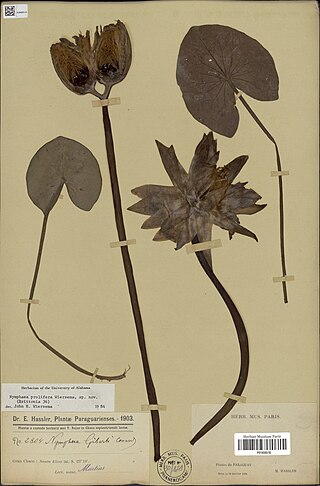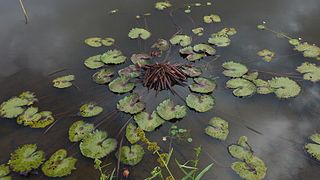
Nymphaeaceae is a family of flowering plants, commonly called water lilies. They live as rhizomatous aquatic herbs in temperate and tropical climates around the world. The family contains five genera with about 70 known species. Water lilies are rooted in soil in bodies of water, with leaves and flowers floating on or rising from the surface. Leaves are oval and heart-shaped in Barclaya. Leaves are round, with a radial notch in Nymphaea and Nuphar, but fully circular in Victoria and Euryale.

Cabomba is an aquatic plant genus, one of two belonging to the family Cabombaceae. It has divided submerged leaves in the shape of a fan and is much favoured by aquarists as an ornamental and oxygenating plant for fish tanks. One species, Cabomba caroliniana, is a nationally declared weed in Australia, where it has choked up waterways after escaping from aquaria.

Cabomba caroliniana, commonly known as Carolina fanwort and various other names, is an aquatic perennial herbaceous plant native to North and South America. Having been a popular aquarium plant, it has been exported around the world, and has become an invasive species in Europe and Australia.

Cabomba furcata is a species of aquatic plant in the water shield family known by the common names red cabomba and forked fanwort. It is native to Central and South America and as far north as Cuba and the tip of Florida. It reaches a maximum height between 30 and 80 centimetres and is up to 8 centimetres (3.1 in) wide. It bears purple flowers.

Nymphaea odorata subsp. tuberosa is a subspecies of Nymphaea odorata native to the region spanning from Central and Eastern Canada, extending to North Central and Northeastern United States.

Nymphaea prolifera is a species of waterlily naturally found from Mexico to Brazil and northeastern Argentina. Additionally, it has been reported to occur in Uruguay.

Nymphaea potamophila is a species of waterlily native to the region spanning from Venezuela to northern Brazil. Additionally, it has been reported to occur in Colombia.

Nymphaea oxypetala is a species of waterlily native to Bolivia, Brazil, Cuba, Ecuador, Paraguay, and Venezuela. It is a remarkable species with excessively acuminate and acute sepals and petals.

Nymphaea rudgeana is a species of waterlily native to the region spanning from Mexico to tropical South America.
Nymphaea tenuinervia is a species of waterlily native to Colombia, Guyana and Brazil.
Nymphaea belophylla is a species of waterlily native to Bolivia, Brazil and Venezuela.
Nymphaea conardii is a species of waterlily native to the region spanning from Southern Mexico to tropical South America.

Nymphaea loriana is a species of waterlily endemic to Manitoba, and Saskatchewan, Canada.
Barclaya rotundifolia is a species of perennial aquatic plant native peninsular Malaysia, and Borneo.
Nuphar ulvacea is a species of rhizomatous aquatic plant native to the US-American states Alabama and Florida.
Nuphar orbiculata is a species of rhizomatous aquatic plant native to the US-American states Alabama, Florida, and Georgia.
Cabomba palaeformis is a species of aquatic plant in the family Cabombaceae native to Mexico and Central America.

Cabomba schwartzii is a species of aquatic plant in the family Cabombaceae endemic to North Brazil.

Trithuria submersa is a species of plant in the family Hydatellaceae endemic to the Australian states New South Wales, South Australia, Tasmania, Victoria, and Western Australia.

Trithuria inconspicua subsp. brevistyla is a subspecies of Trithuria inconspicua in the family Hydatellaceae endemic to the South Island of New Zealand.













